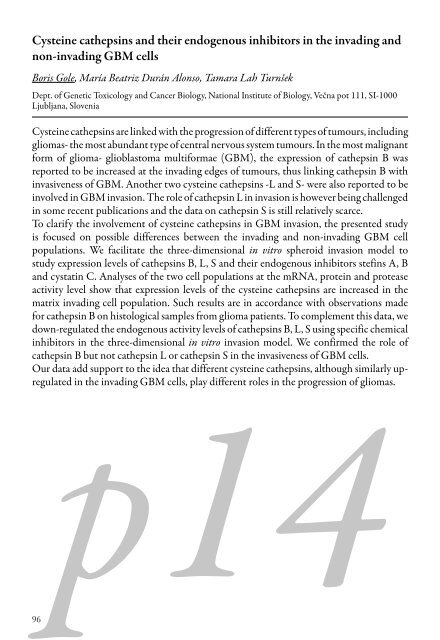Create successful ePaper yourself
Turn your PDF publications into a flip-book with our unique Google optimized e-Paper software.
Cysteine cathepsins and their endogenous inhibitors in the invading and<br />
non-invading GBM cells<br />
Boris Gole, María Beatriz Durán Alonso, Tamara Lah Turnšek<br />
Dept. <strong>of</strong> Genetic Toxicology and Cancer Biology, National Institute <strong>of</strong> Biology, Večna pot 111, SI-1000<br />
Ljubljana, Slovenia<br />
Cysteine cathepsins are linked with the progression <strong>of</strong> different types <strong>of</strong> tumours, including<br />
gliomas- the most abundant type <strong>of</strong> central nervous system tumours. In the most malignant<br />
form <strong>of</strong> glioma- glioblastoma multiformae (GBM), the expression <strong>of</strong> cathepsin B was<br />
reported to be increased at the invading edges <strong>of</strong> tumours, thus linking cathepsin B with<br />
invasiveness <strong>of</strong> GBM. Another two cysteine cathepsins -L and S- were also reported to be<br />
involved in GBM invasion. The role <strong>of</strong> cathepsin L in invasion is however being challenged<br />
in some recent publications and the data on cathepsin S is still relatively scarce.<br />
To clarify the involvement <strong>of</strong> cysteine cathepsins in GBM invasion, the presented study<br />
is focused on possible differences between the invading and non-invading GBM cell<br />
populations. We facilitate the three-dimensional in vitro spheroid invasion model to<br />
study expression levels <strong>of</strong> cathepsins B, L, S and their endogenous inhibitors stefins A, B<br />
and cystatin C. Analyses <strong>of</strong> the two cell populations at the mRNA, protein and protease<br />
activity level show that expression levels <strong>of</strong> the cysteine cathepsins are increased in the<br />
matrix invading cell population. Such results are in accordance with observations made<br />
for cathepsin B on histological samples from glioma patients. To complement this data, we<br />
down-regulated the endogenous activity levels <strong>of</strong> cathepsins B, L, S using specific chemical<br />
inhibitors in the three-dimensional in vitro invasion model. We confirmed the role <strong>of</strong><br />
cathepsin B but not cathepsin L or cathepsin S in the invasiveness <strong>of</strong> GBM cells.<br />
Our data add support to the idea that different cysteine cathepsins, although similarly upregulated<br />
in the invading GBM cells, play different roles in the progression <strong>of</strong> gliomas.<br />
p14<br />
96
















